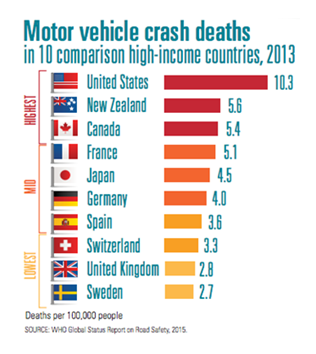| |
US Lags Behind in Reducing Motor Vehicle Crash Fatalities
Since
the early 1970s, deaths due to motor vehicle crashes have been on the
decline in the United States, yet these crashes still kill more than
32,000 people annually and injure more than 2 million. The most recent
CDC VitalSigns report dives into the data on motor vehicle crash
deaths in 20 high-income countries* and takes a look at proven
measures countries have employed to reduce fatalities. The report
clearly demonstrates room for improvement: the US rate of motor
vehicle crash deaths ranks among the highest in the comparison
group(see graphic). According to the report, “over 18,000 lives could
be saved each year if US crash deaths equaled the average rate of 19
other high—income countries.” So, why are we lagging behind our peers
in reducing motor vehicle crash deaths?
There are three major risk factors for motor vehicle
crash deaths in the US.
|
Risk
Factor 1:
Not using or improperly using seat belts, car seats, and booster
seats. About half
of fatalities in US crashes in 2013 weren’t buckled
up. Compared to our high-income peers, front seat belt use is only
87% in the US compared to94% on average. In France, where front
seat belts are in use 99% of the time, it is compulsory to wear a
seat belt. According to the CDC Prevention Status Report on Motor
Vehicle Injuries, as of 2015, only 19 states had primary
enforcement laws on the books covering all seating positions in a
vehicle. The best performing countries also require car seats and
booster seats for child passengers through the age of 8. Again,
America falls short here with only 2 states issuing the same
requirement.
Risk
Factor 2:
Drunk driving. Thirty-one percent of motor vehicle crash deaths in
the US involve alcohol. Only five of the other 19 high-income
countries have similar rates. Additionally, the US, along with
Canada and the UK, has the highest blood alcohol concentration (BAC)
limit (0.08%) to define drunk driving. All other comparison
countries use lower levels (0.02-0.05%). Lower BAC limits
certainly disincentivize impaired driving. Alcohol related crash
deaths can also be reduced by implementing ignition interlocks for
people convicted of drunk driving to keep them off the road when
they are inebriated. According to the CDC, as of 2015, only 26
states require ignition interlocks for all drunk driving offenders
and 20 require them for for repeat offenders.
|
 |
Risk Factor 3:
Speeding. Of the fifteen countries reporting on deaths due to
speeding, the US ranked 8th. Speeding contributed to more than 9,500
US motor vehicle crash deaths in 2013. Automated enforcement along
with targeted media campaigns and increased police presence are proven
measures to decrease speeding. Similar approaches can also be used to
increase seat belt use and decrease impaired driving.
While the US is currently falling short of their peers,
other countries successes suggest the US can make more progress in
reducing motor vehicle crash deaths. Ultimately the path forward
requires buy-in from all levels. The federal government must continue
to track progress and encourage the right programs and policies,
states must be willing to implement those programs and policies, and
drivers and passengers must follow the laws set forth by those
policies. Interestingly, in this report, the use of cell phones while
driving was not indicated as one of the major risk factors for motor
vehicle related death. However, according to a report last Spring from
the National Highway Traffic Safety Administration, distraction
contributed to almost as many deaths as drunk driving in the year
2013. At present, only 14 states have primary enforcement laws
prohibiting the use of handheld cellular devices while driving. This
certainly seems like a risk factor worth considering in the future.
*Australia, Austria, Belgium, Canada, Denmark, Finland, France,
Germany, Ireland, Israel, Japan, Netherlands, New Zealand, Norway,
Slovenia, Spain, Sweden, Switzerland, the United Kingdom, and the
United States.
https://tinyurl.com/hmrftu7
https://tinyurl.com/jzu4o6e
https://tinyurl.com/j8wz78n
■
|
|